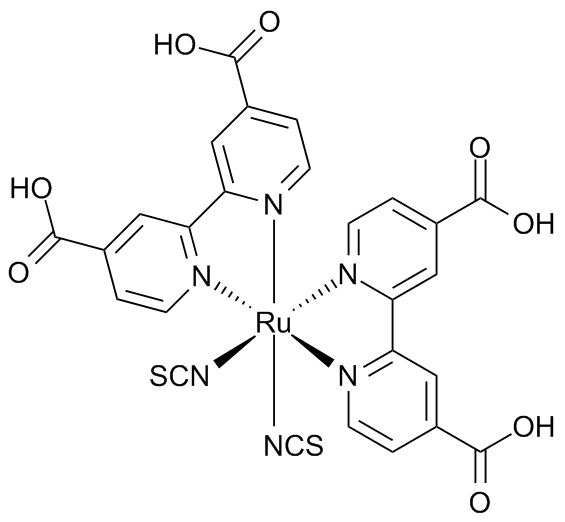C.8 Photovoltaic cells and DSSCs
Written specifically for students to provide help and support for the IB Diploma chemistry programme this page provides full coverage of the syllabus content of Option C - sub topic C.8. It encourages you to think critically and provides many questions with full worked answers so that you can monitor and improve your knowledge and understanding.

 Learning outcomes
Learning outcomes
After studying this topic you should be able to:
 Understand:
Understand:
- The longer the conjugated system within a molecule the longer the wavelength of light absorbed.
- The electrical conductivity of semiconductors increases as the temperature increases whereas the conductivity of metals decreases.
- The doping of silicon to produce n-type and p-type semiconductors increases the conductivity of silicon.
- Photovoltaic cells convert solar energy to electricity.
- DSSCs mimic the way in which plants harness solar energy. Electrons are "injected" from excited molecules directly into the titanium dioxide, TiO2, semiconductor.
- Nanoparticles coated with light-absorbing dyes can be used to increases the effective surface area. This allows more light over a wider range of the visible spectrum to be absorbed.
- Relate the degree of conjugation in the molecular structure to the wavelength of the light absorbed.
- Explain the operation of photovoltaic and dye-sensitized solar cells.
- Explain how nanoparticles increase the efficiency of DSSCs.
- Discuss the advantages of DSSCs compared to the silicon-based photovoltaic cells.
Relationships & vocabulary
Nature of science
The transdisciplinary nature of science can be illustrated by the operation of dye-sensitized solar cells as they use titanium dioxide nanoparticles to mimic photosynthesis.
The initial funding for the research and development of the first photovoltaic cells came from NASA who employed them in space probes.
International-mindedness
Countries with good supplies of sunlight and unused land have the potential to improve economically by harnessing solar energy efficiently.Vocabulary
| photoelectric effect | n-type & p-type semi-conductors | dye-sensitized solar cell (DSSC) |
| doping | Grätzel cell |
Learning slides
You can use this slide gallery for learning or for reviewing concepts and information. It covers all the key points in the syllabus for this sub-topic.
Something to think about
Organometallic ruthenium compounds
A simple dye-sensitized solar cell is easy and cheap to make using a dye such as tea, onion skin or raspberries. Commercial cells are more expensive as they use platinum as the cathode although promising research has been carried out to replace the platinum with cobalt sulfide. This is much cheaper and also more efficient.
Commercial cells also use different light sensitive dyes. Some of the best dyes are organometallic complexes of ruthenium such as cis-bis(isothiocyanato)bis(2,2’-bipyridyl-4,4’-dicarboxylato ruthenium(II). These dyes are highly conjugated and absorb visible light efficiently over a wide wavelength range.

cis-bis(isothiocyanato)bis(2,2’-bipyridyl-4,4’-dicarboxylato ruthenium(II) used in DSSCs
Ruthenium has the ability to accommodate a wide range of oxidation states (from -2 to +8) and organometallic ruthenium compounds have many other uses. They are good catalysts for a wide variety of reactions, for example, dichlorotris(triphenylphosphine)ruthenium(II), RuCl2(PPh3)3, catalyses the oxidation of alcohols and phenols to ketones.
Organometallic ruthenium compounds are also used in chemotherapy and have fewer and less severe effects than platinum based drugs such as cis-platin, PtCl2(NH3)2. Organometallic ruthenium compounds are also showing promise as antimicrobial agents. This is an important area of research as many bacteria are now resistant to penicillins and there is a need to develop new classes of antimicrobials, rather than continue to synthesise drugs based upon analogues with known scaffolds.
Test your understanding of this topic
(Note that your teacher may have restricted your access to some or all of these questions and worked answers if they are going to use them as a class test or set them as an assignment.)
For ten 'quiz' questions (for quick testing of knowledge and understanding with the answers explained) see MC test: Photovoltaic cells & DSSCs.
For short-answer questions see Photovoltaic cells and DSSCs questions together with the worked answers on a separate page Photovoltaic cells and DSSCs answers.
More resources
1. A good explanation of how photovoltaic cells work including n- and p- doping by Thomas Schwenke.
![]() Solar energy & photovoltaic cells
Solar energy & photovoltaic cells
2. An animation showing how dye-sensitized solar cells are constructed and work.
3. Michael Grätzel talks about his own dye-sensitized solar cell.

 IB Docs (2) Team
IB Docs (2) Team 












